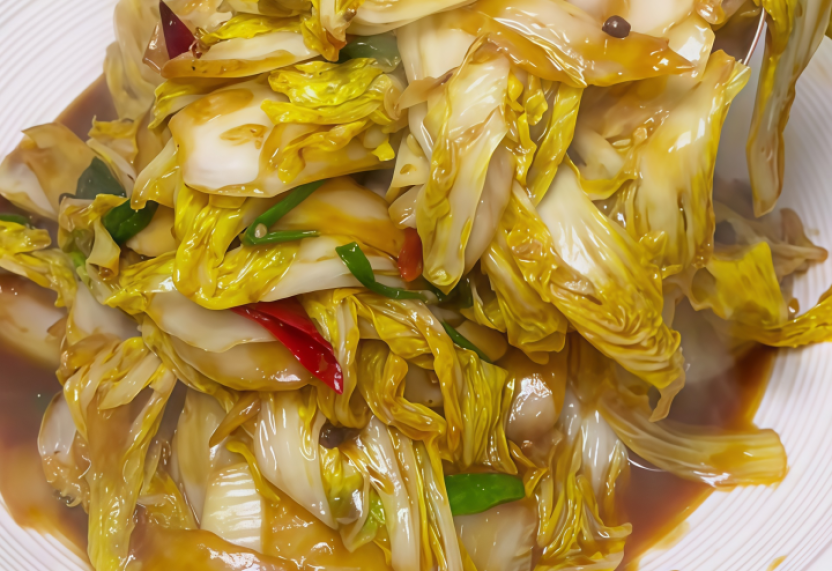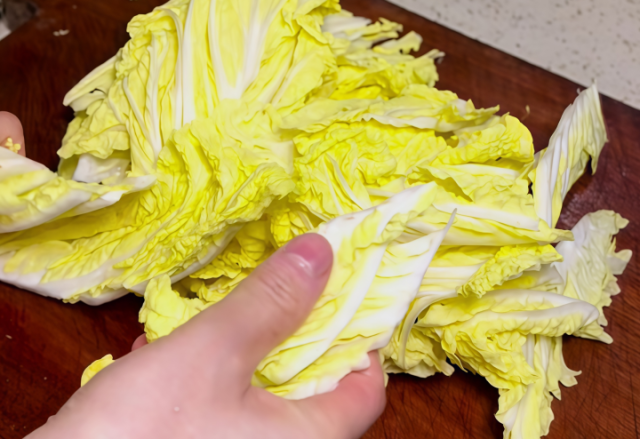Vinegar - Stir - Fried Napa Cabbage Recipe
Vinegar-stir-fried Chinese cabbage is simply a divine dish for whetting the appetite and going well with rice! The sour and tangy charm of vinegar beautifully matches the natural sweetness of Chinese cabbage. With just one bite, the sour and fragrant sensation happily dances on the tip of the tongue, instantly fully activating your taste buds and causing the appetite to surge like a spring.

 2 Comments
2 Comments
Ingredients Needed
Chinese cabbage: Peel off the outer old leaves, separate the cabbage stalks from the cabbage leaves. Cut the cabbage stalks into thin slices obliquely and tear the cabbage leaves into moderately sized pieces by hand for later use.
Light soy sauce: Used to prepare the sauce, adding a salty and fresh flavor to the dish and enhancing the overall taste level.
Vinegar: Can give the dish a rich sour taste and make the taste more abundant. It is an indispensable ingredient in the sauce.
Dark soy sauce: Mainly plays an auxiliary role in coloring, making the dish more attractive in color.
Salt: As a basic seasoning, it can stimulate the taste of the ingredients themselves and highlight the flavor of the dish.
Chicken essence: Effectively increases the umami taste and makes the dish more delicious.
Sugar: An appropriate amount of sugar can adjust the taste and add a hint of sweetness to balance the taste of other seasonings.
Starch: Used to make the sauce and make the sauce thick so that it can better coat the surface of the cabbage.
Peppercorns: Fry in oil until fragrant and then remove, bringing a unique numbing fragrance to the dish.
Scallions: Cut into sections and release fragrance during the frying process to enhance the aroma of the dish.
Garlic: Mince and use for frying to give the dish a rich garlic flavor.
Dried chili peppers: Cut into sections to add spiciness and bring a unique spicy stimulation to the dish.
Cooking oil: Used for frying during the cooking process to make the ingredients evenly heated and absorb the taste of seasonings.
The correct way to cut Chinese cabbage
First, peel off the outer old leaves of Chinese cabbage. Then, cut it in half lengthwise to separate the cabbage stalks from the leaves. The cabbage stalks are hard in texture. Cut them into thin slices obliquely. This can increase the surface area and facilitate quick cooking and absorption of seasonings. The cabbage leaves are relatively tender. Tear them into moderately sized pieces by hand. Tearing by hand can better preserve the leaf fibers and make the taste better and the heating more even. After cutting and tearing, place them aside respectively for later use. In this way, when cooking, put the cabbage stalks first. After they are just cooked, then add the cabbage leaves. This can ensure that both are cooked to the same degree, making the whole vinegar-stir-fried Chinese cabbage achieve the ideal effect in taste and texture and adding a unique flavor to the dish.
How to avoid overcooking Chinese cabbage
First, separate the cabbage stalks and leaves. When frying, put the stalks first and stir-fry over medium heat until they are just cooked. Since the stalks are hard, they need more time to be heated. Then put the leaves and immediately turn to high heat. Use high heat to make the leaves quickly heated to lock in moisture and quickly become just cooked. The whole process should be short. After the leaves are just cooked, stir-fry for 1-2 minutes. During cooking, always pay attention to the state of the cabbage. When the stalks are transparent and there is no hard core, and the leaves are slightly softened and still have toughness, it is the best. At this time, pour in the seasoned sauce immediately and stir-fry evenly and then take out of the pan. By precisely controlling the cooking sequence, time and heat, and carefully observing the state of the ingredients, the vinegar-stir-fried Chinese cabbage can have a crisp and tender taste and avoid being overly cooked and affecting the flavor and texture.
How to store the remaining ones
Refrigeration for freshness preservation:
After the vinegar-stir-fried Chinese cabbage cools down, put it into a sealed container to isolate air and odors, and place it in the refrigerator's refrigeration compartment. It can be stored for about 3 days. Low temperature can inhibit microorganisms and delay spoilage. However, as time passes, the taste and flavor will gradually be lost.
Warming up and adding flavor:
When eating refrigerated dishes, heat them slowly over medium-low heat in a stove frying pan or wok, and add a little rice vinegar. Vinegar can enhance the flavor. Its acidity can help restore the crispness and tenderness of Chinese cabbage and revitalize the dish. After heating, it should be eaten as soon as possible and should not be refrigerated again.
Disadvantages of freezing:
Freezing this dish is not recommended. When freezing, the water in Chinese cabbage forms ice crystals. Ice crystals damage cells. After thawing, the texture becomes soft and mushy, and the taste and quality are seriously damaged. Even if it is cooked again, it is difficult to restore. Therefore, freezing is not a suitable storage method for vinegar-stir-fried Chinese cabbage.
INGREDIENTS
MAIN INGREDIENTS
- 1 head of Chinese cabbage
ACCESSORIES
- 10g scallions
- 10g garlic
- 5g dried chili peppers
- 5g peppercorns
SEASONINGS
- 20ml light soy sauce
- 30ml vinegar
- 5ml dark soy sauce
- 3g salt
- 2g chicken essence
- 5g sugar
- 5g starch
- 20ml cooking oil
DIRECTIONS
STEP 1
Carefully process the Chinese cabbage. After peeling off the outer old leaves, cut it in half. Separate the cabbage stalks from the cabbage leaves. Cut the cabbage stalks into thin slices obliquely. Tear the cabbage leaves into moderately sized pieces by hand. Store them separately for later use.

STEP 2
Take a small bowl and add 20 milliliters of light soy sauce, 30 milliliters of vinegar, 5 milliliters of dark soy sauce, 3 grams of salt, 2 grams of chicken essence, 5 grams of sugar and 5 grams of starch in turn. Stir well until the starch is dissolved to make the seasoned sauce for later use.

STEP 3
Pour 20 milliliters of cooking oil into the pot and heat it over medium heat. After the oil is hot, add 5 grams of peppercorns. After frying until fragrant, remove the peppercorns and discard them.

STEP 4
Put 10 grams of scallion sections, 10 grams of minced garlic and 5 grams of dried chili pepper sections into the pot and stir-fry quickly to stimulate the fragrance.

STEP 5
Put the cabbage stalk slices into the pot first and stir-fry continuously until the stalk slices are just cooked.

STEP 6
Immediately pour in the cabbage leaves and quickly stir-fry over high heat until the leaves are just cooked.

STEP 7
Pour in the adjusted sauce, stir-fry evenly over high heat to ensure that each piece of cabbage is covered with the sauce, and then take out and serve on a plate.

More recipes worth trying
Napa Cabbage Stir-fry (Suan La Bai Cai)
Stir-Fried Napa Cabbage with Vinegar recipes
Chinese Pickled Cabbage (Szechuan Style)
Food pairing
Rice: The sweet and sour taste of vinegar-stir-fried Chinese cabbage complements rice well. The softness of rice can neutralize the sourness of Chinese cabbage. At the same time, the soup of Chinese cabbage can soak the rice and increase the flavor of the rice, making every bite full of rich taste.
Steamed buns: The wheat fragrance of steamed buns combined with vinegar-stir-fried Chinese cabbage forms a simple and wonderful combination. Eating Chinese cabbage sandwiched in steamed buns, the fluffy texture of steamed buns and the crisp and tender taste of Chinese cabbage set off each other, giving a unique flavor.
Noodles: Whether it is clear soup noodles or mixed noodles, adding vinegar-stir-fried Chinese cabbage can enhance the taste level of the whole pasta. The freshness of Chinese cabbage can relieve the monotony of noodles, and its soup can also add a unique flavor to noodles.
Eggs: Can be made into stir-fried Chinese cabbage with eggs. The mellow fragrance of eggs combined with the freshness of Chinese cabbage. The golden color of eggs and the green color of Chinese cabbage are also visually attractive, enriching the nutritional composition and taste of the dish.
Meat: Such as pork, beef, etc. When paired with pork, the fat of pork can moisten Chinese cabbage and make its taste more mellow. Paired with beef, the chewiness and rich meaty aroma of beef form a sharp contrast with the crispness of Chinese cabbage, increasing the richness and satiety of the dish.
Recipe Tips
Selection of cooking tools: It is recommended to use an iron pot or stainless steel pot for frying. Pots made of these two materials heat evenly and can better control the heat, so that Chinese cabbage is heated stably during the frying process and reduces the occurrence of local scorching or uneven cooking.
Tips for choosing Chinese cabbage: When choosing Chinese cabbage, give priority to those with white stems, tight leaves, no obvious damage and fresh and unspoiled roots. Heavier Chinese cabbages with a solid feel have sufficient moisture and good taste.
Tricks for cutting vegetables: Cut the cabbage stalks evenly in thickness so that they are heated evenly. Tear the cabbage leaves into moderately sized pieces. They are easy to stir-fry and can maintain the taste and shape.
Key to mastering the heat: Use medium heat to fry peppercorns to prevent scorching and bitterness. First stir-fry the cabbage stalks over medium heat until soft, then turn to high heat and add the cabbage leaves. High heat can lock in moisture and keep it crisp and tender. After pouring in the seasoned sauce, stir-fry quickly over high heat for a few times and then take it out of the pan to make the Chinese cabbage crisp and evenly coated with sauce.
Secret of preparing the seasoned sauce: When preparing the sauce, first stir the starch with a small amount of water until it is well mixed and then add other ingredients to avoid starch lumping. You can also fine-tune it according to your personal taste. If you like sour taste, you can add more vinegar. If you like sweet taste, increase the amount of sugar slightly.
Recipe analyzer
- Recipes: Vinegar - Stir - Fried Napa Cabbage Recipe
- Main Ingredients:5
- Servings per recipe:1
- Servings size:870 g
-
Energy (calories):158 kcal
-
Protein:13.58 g
-
Fat:4.83 g
Why gray?

-
Carbohydrates:23 g
-
Protein: 21%33 kcal
-
Fat: 27%42 kcal
-
Carbohydrates: 52%83 kcal

The ratio shows whether the proportion of both fatty acids in your diet is optimal. Red color means too much of Omega 6 or too little of Omega 3. The data are rounded off and approximate.











2 REVIEWS